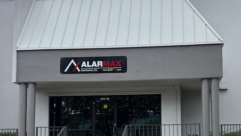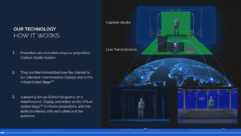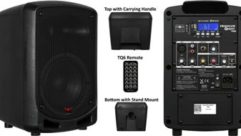
Projection Mapping on the Venetian Hotel
Feb 10, 2013 6:53 PM,
By Cynthia Wisehart
Projection-mapped install is an entertainment and advertising platform

The Venetian Las Vegas has one of the country’s fewfixed installation architectural video projection systems. Installed last summer it isused for nighttime spectaculars; the current show Winter in Venice openedin November.
The permanent architectural projection system at the Venetian Hotel in Las Vegas could be considered digital signage, large-format projection, or art. Or all three. The tradition of the nighttime spectacular goes back at least to the days of son et lumière (literally sound and light). A very few pioneering artists have since mapped still images and more recently video onto the contours of a building or natural environment—even onto a moving car.
In recent years, high-profile occasions, especially in Europe, feature dramatic projection mapping supported with what is often equally evocative: music. This amazing art form dazzles and transforms by night and literally vanishes by day, without a trace. The combination of very high impact and inconspicuous footprint makes it a shape-shifting and creative platform both for entertainment and commerce.
While most projection-mapped spectaculars have been event driven, a few so far—such as the system at the Venetian Hotel—are fixed installations. As such, with a change of content, they can support an ongoing variety of entertainment and marketing for the venue; these systems can also deliver new revenue as a high impact alternative for brand marketers. Architectural projection can blow away the biggest LED screen in terms of resolution, brightness, and creativity—at night anyway.
All this impact comes at a price, technically speaking. It is a format for experts, both in terms of the content and the playback systems. “The complex issues associated with large-scale video-mapping projects are not always readily apparent to the end-user,” says Mike Brown-Cestero of integrator AVDB Group, Las Vegas, who first encountered the Venetian project while bidding it for his previous employer. Paul Turner, who is AVDB’s project manager for the Venetian install, says that by the time he went to work on the project for a midsummer installation, the design had evolved to better reflect the scope and horsepower required.
Even so, Turner says, the job brought more unforeseen challenges than many integration jobs. “These types of projects are integration in the truest sense of the word,” Turner says. At the Venetian, new and legacy systems converged as did a variety of engineering and construction disciplines. That’s usually the case, of course, but rarely at this scale, in part because the systems have to operate so precisely. If you are in a boardroom and a projector is underpowered or under-cooled, has the wrong angle, or its alignment tends to slip a little, the fix might be a low enough cost to readily absorb. But a miscalculation with large-format projection can be a much costlier proposition to fix. This makes sense when you consider that just the four 35K Christie projectors that fill the 25×25-meter façade likely tally up in the $750,000 range.
Brown-Cestero says the original RFP presumed that less brightness would be required, and that source playback, cabling, and control would all be more like you might expect for a digital signage project. However, the high ambient light of the Las Vegas Strip, the viewing angles, and the geographic distance among systems components soon dictated more lumens and fiber-optic cable, as well as a true control system (in this case Alcorn-McBride V16 Pro) to bring together lighting, audio, and projector control; to interface with the mapping engine and the United Visual Artists’ d3; and to pick up some control duties for dimming and BGM.
“One of the biggest challenges was ambient light,” Turner says. In addition to the Strip spill, the hotel itself is bathed in an extensive array of 13-year-old lighting systems. Those lights had to come off for the show. The answer: individual event timers at every one of the far-flung, un-networked dimmers. “A whole part of this system, in some ways the hardest part, was simple high-school engineering-style contact closures,” Turner says with a laugh.
Another source of ambient light is the three gigantic LED screens mounted on a small tower (the “Customs House”) in the Venetian’s lagoon directly across from the projection-mapped façade. Since the servers were located in another part of the Venetian campus, it was event controllers for those screens/servers too (though at press time there was a plan to relocate the servers and bring them under the V16 control).
The other answer, of course, came from the very bright Christie projectors, which in turn brought the next challenge: heat. The projectors are housed in the Customs House tower, framed on three sides by those big LEDs. A 6-ton air-conditioning unit (about the size of a Volkswagon bug) sits on top of the tower. Turner says moving ballast out of the building also helped with the heat load.

The “Customs House” tower at the center of the lagoon (farleft of picture) houses four 35K Christie projectors; content is served via fiber bytwo United Visual Artists D3 graphics engines in the hotel’s main control room.
Because projection-mapped content requires very precise alignment of the projectors, AVDB also designed and built a track and dolly system to hold the projectors so they could be slid in and out of a locked position for service. Audio playback is through a L’Acoustics central cluster. Turner says it sounds beautiful, and that L’Acoustics (like Christie) was invaluably supportive. However, due to architectural and sightline limitations, the speakers could not be configured for stereo, and therefore could not deliver on the stereo and pan mix that was the sound artists’ intent. People see the show from far right or far left and not from the center of the lagoon and hear a mono mix from a stereo source.
The centerpiece of the control architecture is the Alcorn McBride V16 Pro, which controls the MediaMatrix audio distribution, the D3 video/mapping players, the projectors, and the two tri-signs above the building. The audio is not embedded in the video, though both sound and picture play off the three D3 players (a master that drives two projectors, a slave that drives the other two, and a redundant player that can switch in to cover either master or slave in the event of a failure). The signal is DVI out to fiber for the 750ft. run from the control room to the projectors, and back to DVI in.
The D3 player does not just play the media, it holds the 3D mapping data files of the building which are used to exactly apply the imagery to the building. That mapping data can be shared with other content creators to allow them to design content specifically for the building. That could be for a show (the Venetian has done two so far) or potentially for an advertising client who wants to rent the system and the façade for brand marketing—digital signage writ large.
While the Venetian install had many elements in common with other architectural projection systems, there were a couple of unique features for the site. One of those elements is an iPad-like (it’s a PC) wireless control system that allows operators to control the entire projection and audio system, as well as some of the lighting and legacy CobraNet-connected BGM/bell tower systems from anywhere in the plaza. (Luckily, the original CobraNet programmer was still onsite to help pull that part off).
Also unique is the way the system uses two Tri-signs at the top of the hotel. Working with the manufacturer at the artist’s request, a method was designed to toggle the signs (which normally display an ad for the Venetian’s Tao nightclub) to a neutral beige tone that matched the building as the shows start. This allowed the artist to treat the signs as a projection surface, a seamless extension of the building architecture.
While projection mapping is not new (and if you go back to the original days of son et lumière, it’s quite old), it is still a niche with only a handful of world-class content creators. “And the industry is still on the learning curve on these systems,” Turner adds. He means that not just technically but also in terms of how to best use the technology and the platform it provides, especially when it comes to a fixed installation. Brown-Cestero says that now AVDB has clients who are conceiving the system as an advertising platform and revenue stream; new Las Vegas zoning regulations expand the percentage of a building façade that can be used for advertising, which helps make that a feasible goal.
“It is very high impact,” Turner says of technology and the current Venetian show Winter in Venice, which opened in December and has been described as “monumental.” “It stops traffic. And the YouTube videos don’t do it justice.”
The Content Creator: Ross Ashton, The Projection Studio
Ross Ashton is probably most famous for his projection creations for Buckingham Palace, Windsor Palace, and the 2012 London Olympics. In the U.S., he has performed transformations on the New York Public Library and Dartmouth College, as well as two shows for the Venetian—Carnivale and the current Winter in Venice. His work—often combined with that of sound artist Karen Monid—has been seen throughout the world, at some of the one-of-a-kind events, historical commemorations, fashion shows, rock concerts, and festivals.
Born at a time when nearly every village in France entertained tourists with son et lumière (sound and light) spectaculars, Ashton trained in photography and theater, and spent 4 years with ETC, Paris. He’s worked in both slide and video projection, and done mapped projects with both (“slides are still very bright and relatively inexpensive compared to video”). He began specializing in high power projection in 1992; 10 years later, his Buckingham Palace piece for the Queen’s Golden Jubilee helped bring projection-mapped spectaculars into the British consciousness.
His storytelling is most often historical and his images often come from historical photographs. His software toolkit includes Photoshop, After Effects, and Cinema 4D. To map the building, he laser scans it into an exact 3D replica mode through the software in the D3 graphics engine/player.
“Most of my work is a celebration of the historical, of the building and its place in history. If I can possibly use a real photograph, I do. I invent as little as possible,” he says. Video, he says, allows you do more things, some of them reenactments such as blowing in up a castle to invoke Oliver Cromwell and the English civil war.
“And yet everything we do is completely non-destructive,” he says. “We can take a building and reimagine it for night into a different building and then put it back for the daytime. For the visitors, it’s two different experiences and yet we have not altered it in any way.”
For playback, Ashton says he doesn’t like to be too precious about things. He knows and likes the Alcorn and Dataton products, most of the large-format projectors and the high-end speakers. Though his company can—and sometimes does—specify the system design, he likes to work with local integrators and suppliers to build systems that will be comfortable for the local end-user to operate and maintain. Next up: the Venetian’s spring show.
Projection Mapping on the Venetian Hotel
Feb 10, 2013 6:53 PM,
By Cynthia Wisehart
Projection-mapped install is an entertainment and advertising platform
Because projection-mapped content requires very precise alignment of the projectors, AVDB also designed and built a track and dolly system to hold the projectors so they could be slid in and out of a locked position for service. Audio playback is through a L’Acoustics central cluster. Turner says it sounds beautiful, and that L’Acoustics (like Christie) was invaluably supportive. However, due to architectural and sightline limitations, the speakers could not be configured for stereo, and therefore could not deliver on the stereo and pan mix that was the sound artists’ intent. People see the show from far right or far left and not from the center of the lagoon and hear a mono mix from a stereo source.
The centerpiece of the control architecture is the Alcorn McBride V16 Pro, which controls the MediaMatrix audio distribution, the D3 video/mapping players, the projectors, and the two tri-signs above the building. The audio is not embedded in the video, though both sound and picture play off the three D3 players (a master that drives two projectors, a slave that drives the other two, and a redundant player that can switch in to cover either master or slave in the event of a failure). The signal is DVI out to fiber for the 750ft. run from the control room to the projectors, and back to DVI in.
The D3 player does not just play the media, it holds the 3D mapping data files of the building which are used to exactly apply the imagery to the building. That mapping data can be shared with other content creators to allow them to design content specifically for the building. That could be for a show (the Venetian has done two so far) or potentially for an advertising client who wants to rent the system and the façade for brand marketing—digital signage writ large.
While the Venetian install had many elements in common with other architectural projection systems, there were a couple of unique features for the site. One of those elements is an iPad-like (it’s a PC) wireless control system that allows operators to control the entire projection and audio system, as well as some of the lighting and legacy CobraNet-connected BGM/bell tower systems from anywhere in the plaza. (Luckily, the original CobraNet programmer was still onsite to help pull that part off).
Also unique is the way the system uses two Tri-signs at the top of the hotel. Working with the manufacturer at the artist’s request, a method was designed to toggle the signs (which normally display an ad for the Venetian’s Tao nightclub) to a neutral beige tone that matched the building as the shows start. This allowed the artist to treat the signs as a projection surface, a seamless extension of the building architecture.
While projection mapping is not new (and if you go back to the original days of son et lumière, it’s quite old), it is still a niche with only a handful of world-class content creators. “And the industry is still on the learning curve on these systems,” Turner adds. He means that not just technically but also in terms of how to best use the technology and the platform it provides, especially when it comes to a fixed installation. Brown-Cestero says that now AVDB has clients who are conceiving the system as an advertising platform and revenue stream; new Las Vegas zoning regulations expand the percentage of a building façade that can be used for advertising, which helps make that a feasible goal.

Two Tri-sign billboards at the top of the buildingdouble as projection surfaces; in this image they are the top balconies of the “MarcoCafé.”
“It is very high impact,” Turner says of technology and the current Venetian show Winter in Venice, which opened in December and has been described as “monumental.” “It stops traffic. And the YouTube videos don’t do it justice.”
The Content Creator: Ross Ashton, The Projection Studio
Ross Ashton is probably most famous for his projection creations for Buckingham Palace, Windsor Palace, and the 2012 London Olympics. In the U.S., he has performed transformations on the New York Public Library and Dartmouth College, as well as two shows for the Venetian—Carnivale and the current Winter in Venice. His work—often combined with that of sound artist Karen Monid—has been seen throughout the world, at some of the one-of-a-kind events, historical commemorations, fashion shows, rock concerts, and festivals.
Born at a time when nearly every village in France entertained tourists with son et lumière (sound and light) spectaculars, Ashton trained in photography and theater, and spent 4 years with ETC, Paris. He’s worked in both slide and video projection, and done mapped projects with both (“slides are still very bright and relatively inexpensive compared to video”). He began specializing in high power projection in 1992; 10 years later, his Buckingham Palace piece for the Queen’s Golden Jubilee helped bring projection-mapped spectaculars into the British consciousness.
His storytelling is most often historical and his images often come from historical photographs. His software toolkit includes Photoshop, After Effects, and Cinema 4D. To map the building, he laser scans it into an exact 3D replica mode through the software in the D3 graphics engine/player.
“Most of my work is a celebration of the historical, of the building and its place in history. If I can possibly use a real photograph, I do. I invent as little as possible,” he says. Video, he says, allows you do more things, some of them reenactments such as blowing in up a castle to invoke Oliver Cromwell and the English civil war.
“And yet everything we do is completely non-destructive,” he says. “We can take a building and reimagine it for night into a different building and then put it back for the daytime. For the visitors, it’s two different experiences and yet we have not altered it in any way.”
For playback, Ashton says he doesn’t like to be too precious about things. He knows and likes the Alcorn and Dataton products, most of the large-format projectors and the high-end speakers. Though his company can—and sometimes does—specify the system design, he likes to work with local integrators and suppliers to build systems that will be comfortable for the local end-user to operate and maintain. Next up: the Venetian’s spring show.









